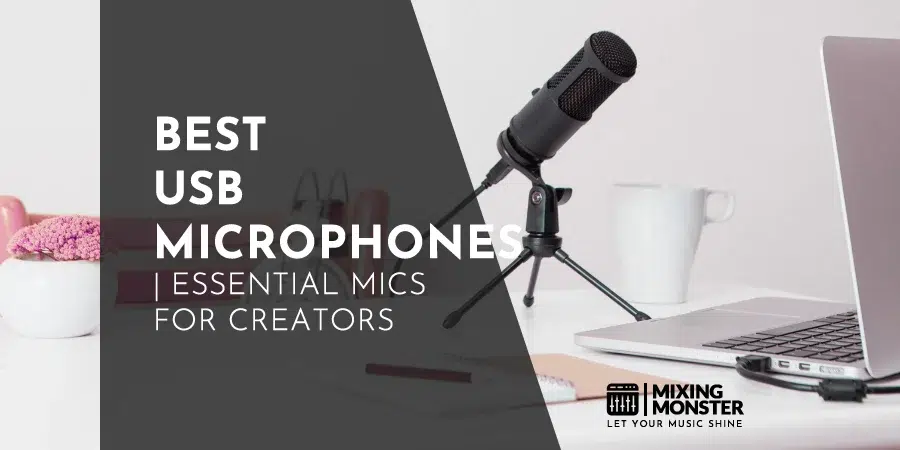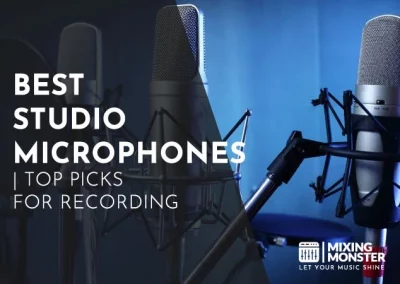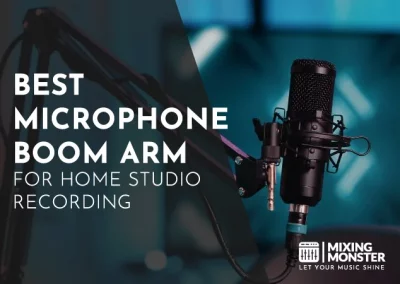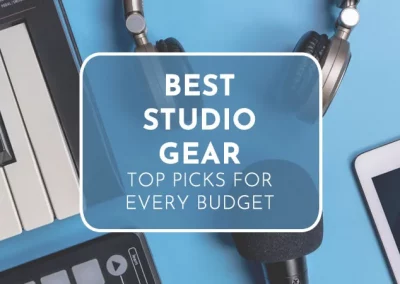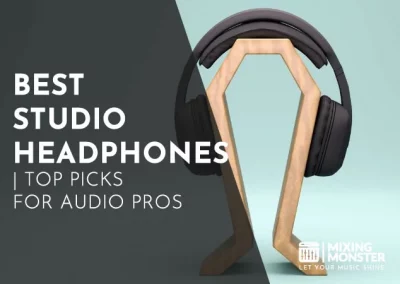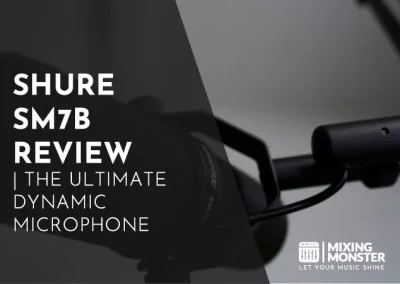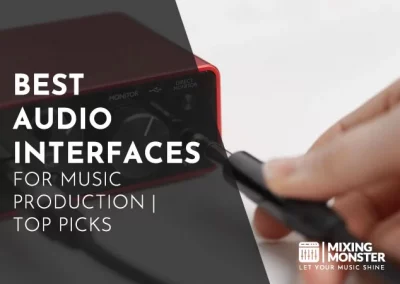Home > Blog > Studio Gear > Home Studio Gear
Disclosure: Some of the links below are affiliate links, meaning that at no additional cost to you, we will receive a commission if you click through and make a purchase. Read our full affiliate disclosure here.
Recording high-quality audio from home has never been more accessible than with today’s best USB microphones. These plug-and-play devices let you skip the complex audio interfaces and still get professional-grade sound quality.
USB microphones connect directly to computers via USB cable, converting analog audio signals to digital format without requiring additional hardware or drivers. They come with built-in analog-to-digital converters and preamps and are perfect for podcasting, streaming, voiceovers, and home recording.
Most USB microphones offer zero-latency headphone monitoring through integrated headphone jacks. You’ll find popular pickup patterns like cardioid for focused recording and omnidirectional for picking up the whole room. Many models toss in real-time controls for gain, mute, and headphone volume, which is just handy.
When you’re picking out a USB microphone, you’ll want to look at the pickup pattern, frequency response, and build quality first. Sample rate and bit depth determine how crisp your audio turns out—48kHz/16-bit is the usual sweet spot for most folks.
Think about whether you need features like gain control, mute buttons, or rock-solid compatibility with your operating system. We spent a lot of time researching and testing dozens of USB microphones to find the ones that really deliver on audio quality and reliability.
KEYNOTES:
- In this article, you’ll find a comprehensive list of the best USB microphones on the market.
- USB microphones are categorized into 3 sections:
Best Budget USB Microphones
Best Midrange USB Microphones
Best High-End USB Microphones - Each section contains:
3-5 USB Microphones
ordered by price (low > high)
Our Top Picks – Best USB Microphones
Best Budget
RØDE
NT-USB Mini
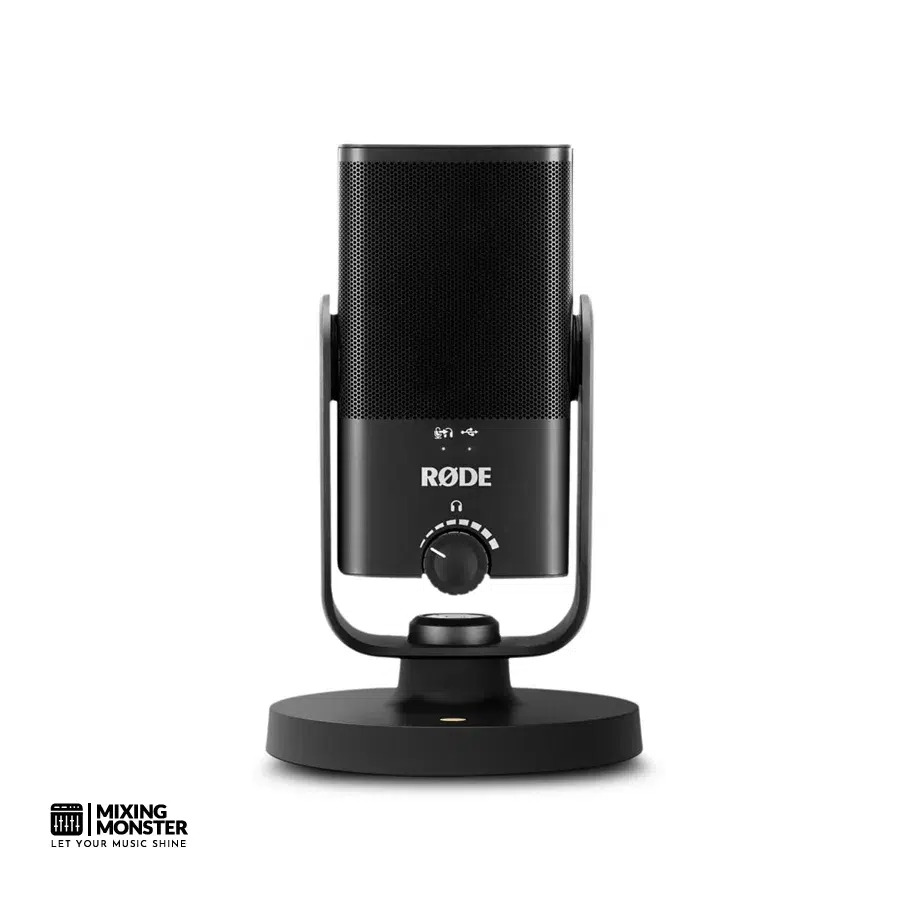
Best Midrange
AKG
Lyra Ultra-HD USB C
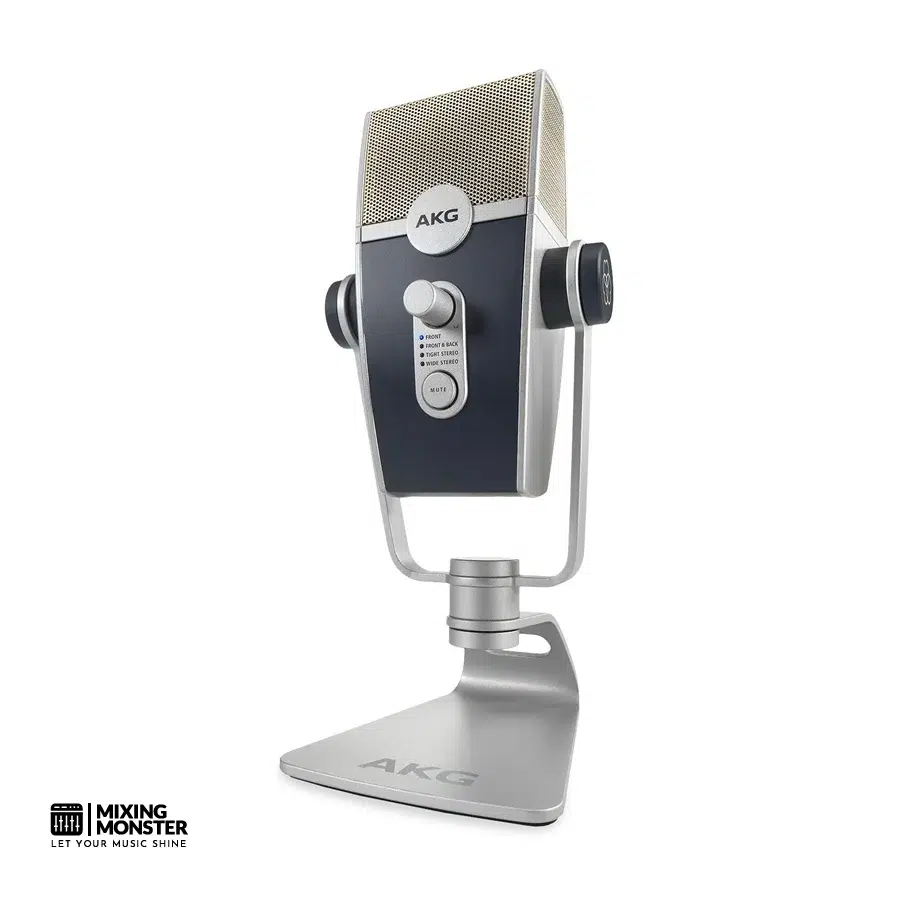
Best High-End
Apogee
HypeMiC
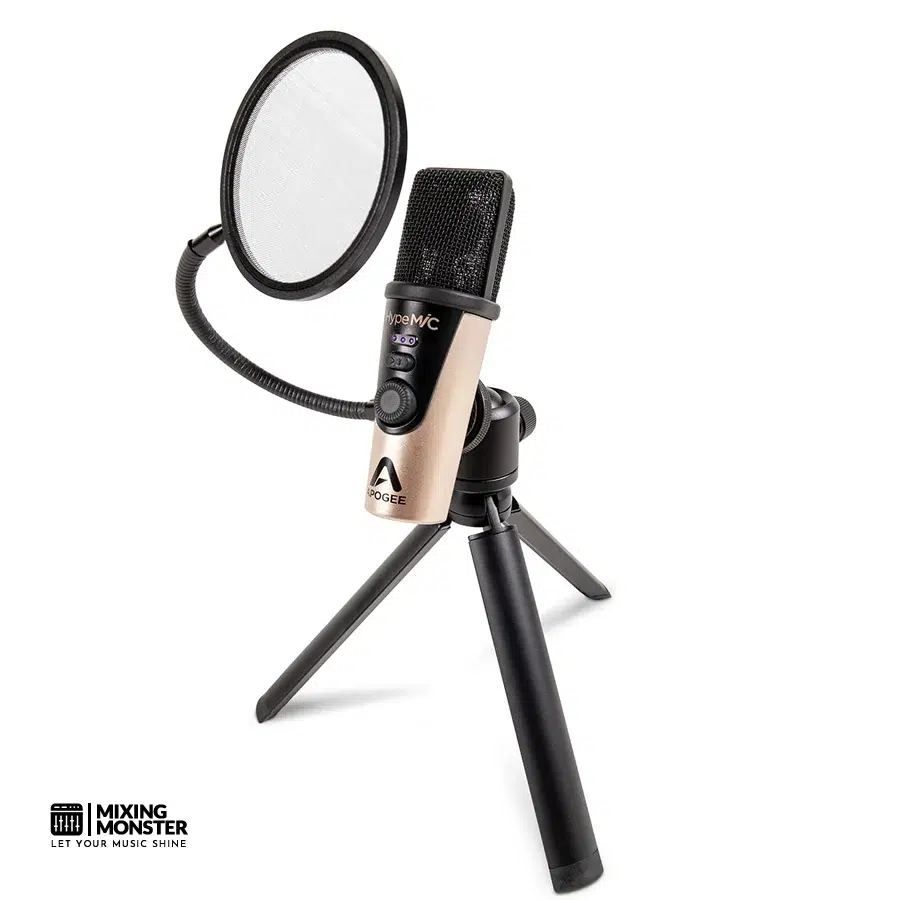
Table Of Contents
1. What Are The Best USB Microphones?
Best Budget USB Microphones
Best Midrange USB Microphones
Best High-End USB Microphones
2. What Is A USB Microphone?
3. Essential Accessories To Complement Your USB Microphone
4. USB Microphone Buying Guide
5. Finding Your Perfect USB Microphone: Key Takeaways
FAQ

1. What Are The Best USB Microphones?
Here’s our comprehensive list of the top USB microphones currently available. We examined audio quality, build construction, and overall value to help you select the right microphone for your setup.
Here Are Our Picks For The Best USB Microphones:
Best Budget USB Microphones
2. SE Electronics Neom USB
Best For Content Creators, Streamers, And Mobile Recording
Best Midrange USB Microphones
Best High-End USB Microphones

Best Budget USB Microphones
#1 Mackie EM-91CU+
Best For Small Home Studios And Content Creators
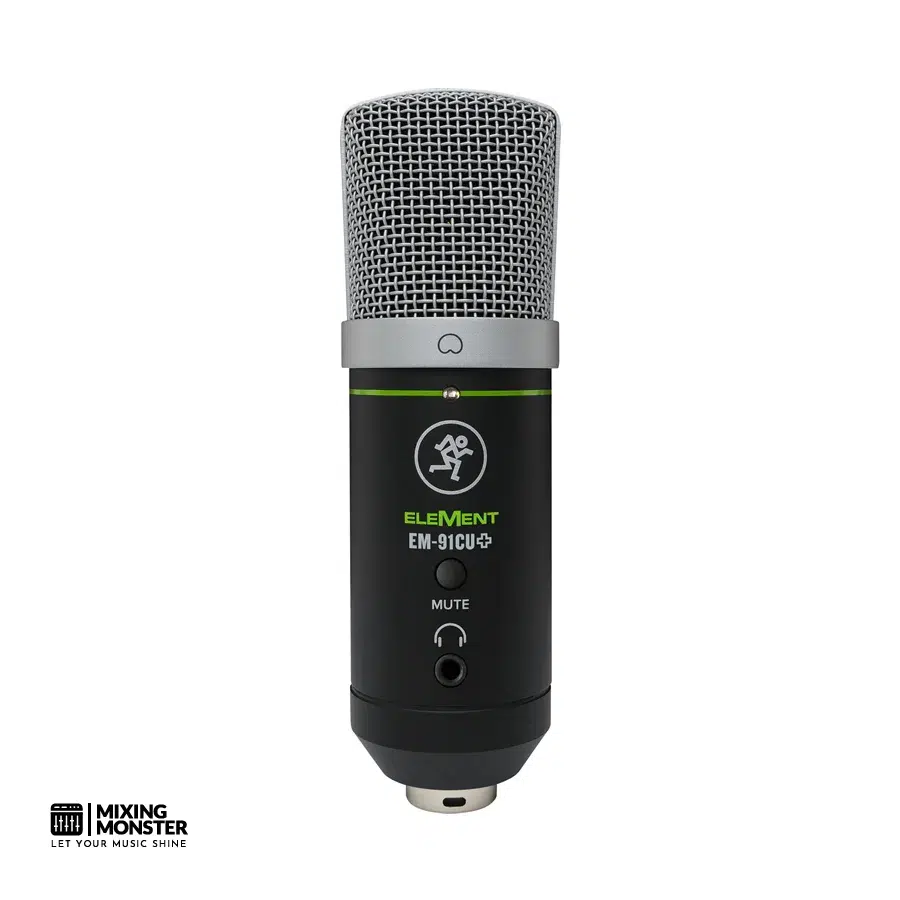
Overview:
The Mackie EM-91CU+ USB Condenser Microphone builds on its predecessor with enhanced features that streamline recording workflows. This large-diaphragm condenser provides 24-bit/96kHz recording quality, along with easy onboard controls.
We found the EM-91CU+ captures professional-grade audio with true plug-and-play simplicity. The included shock mount and software bundle really add value to this sturdy microphone.
Pros:
- The onboard mute button and headphone output give you real-time monitoring control
- Solid build with professional components and low-noise circuitry
- Comes with Waveform OEM and a 16-plugin bundle
- Zero-latency headphone monitoring means no annoying recording delays
- Just plug it in—no drivers or software needed
Cons:
- Large diaphragm picks up more room noise, so you’ll want a treated space
- A heavier build might stress lighter boom arms during long sessions
- High sensitivity can bring in unwanted noise from untreated rooms
Unique Selling Point:
The Mackie EM-91CU+ stands out with its hardware controls and generous software bundle, providing both instant usability and real creative firepower in one package.
Key Benefits:
- Immediate Recording Capability – Plug-and-play enables you to start recording within minutes, so you’re not stuck troubleshooting.
- Professional Monitoring Control – Onboard mute and headphone output let you monitor precisely, no software required.
- Complete Creative Package – The Waveform OEM and plugin bundle means you’ve professional mixing and editing tools from day one.
Pricing:
| Average Price | ~ $52 |
Review:
The Mackie EM-91CU+ really impressed us for content creators who want pro-level audio without a headache. We put this mic through its paces in various recording scenarios, and honestly, its audio capture exceeded our expectations for the price. That large diaphragm brings out rich, detailed recordings with excellent frequency response across vocals.
Setup? Couldn’t be easier. Just plug it in and go—no drivers, no drama. The onboard mute button is a lifesaver during takes, letting you cut the mic instantly without fiddling with software. Direct headphone monitoring, right from the mic, means you don’t experience the annoying latency that sometimes occurs with software monitoring.
The build feels solid and inspires confidence. The weight and construction suggest it’ll last a long time. We liked the included shock mount—it did a good job isolating the mic from desk bumps and handling noise. It looks sharp, too, so it fits right in whether you’re in a home studio or an office.
Audio-wise, you hear the quality in the components and low-noise circuitry. We recorded vocals, instruments, and podcasts, and everything came out clear. The unidirectional pickup pattern excels at blocking off-axis noise while preserving a natural sound. Just a heads up, though: the high sensitivity means you’ll want to pay attention to your room acoustics—otherwise, you might catch more ambient noise than you bargained for.
The software bundle is a real plus. Waveform OEM provides a capable DAW, and the included plugins—especially the EQ, compressor, and reverb—are genuinely helpful in refining your recordings. For beginners who want a complete solution out of the box, this package is hard to beat.
Yes, it’s a bit sensitive to room noise and on the heavier side, so some acoustic treatment and a sturdy boom arm are helpful. But all things considered, the Mackie EM-91CU+ offers a fantastic deal for creators who want pro USB mic performance with convenient hardware controls.
#2 SE Electronics Neom USB
Best For Content Creators, Streamers, And Mobile Recording

Overview:
The SE Electronics NEOM USB packs professional condenser quality into a plug-and-play package that works everywhere. This mic’s universal compatibility really stands out—it works seamlessly with Mac, Windows, iOS, and Android devices, requiring no additional drivers.
The NEOM USB features SE Electronics’ signature sound and incorporates modern enhancements, including zero-latency monitoring and a custom ASIO driver for Windows users. With its solid metal build and sleek design, you get everything you need to start recording right away.
Pros:
- Zero-latency headphone monitoring means no audio lag while recording or streaming
- Works with desktop and mobile platforms—no drivers, no fuss
- Sturdy all-metal build, comes with a desktop stand and pro mic clip
Cons:
- Heavier than some, so not the most portable option
- Not a ton of long-term user reviews yet
- Costs more than some basic USB mics
Unique Selling Point:
The NEOM USB is the only mic in its class that truly nails universal compatibility with custom ASIO support, making it just as applicable in the studio as it is on the go.
Key Benefits:
- Professional Audio Quality – Delivers studio-grade condenser sound with 24-bit resolution and up to 192 kHz sampling for broadcast-quality recordings.
- Seamless Device Integration – Instantly works with any device or platform—no setup headaches.
- Complete Recording Solution – Includes all the necessary accessories and monitoring equipment to get started right away.
Pricing:
| Average Price | ~ $99 |
Review:
We found the SE Electronics NEOM USB to be a pretty great combination of professional audio engineering and everyday usability. The plug-and-play experience is honestly a breath of fresh air. Whether we hooked it up to a MacBook Pro for podcasts or plugged it straight into an Android phone for quick mobile content, it worked instantly—no fiddling, no drivers, go.
The zero-latency headphone monitoring made a massive difference in our sessions. Hearing yourself in real time through the mic’s headphone jack? It’s a game-changer, especially for live streaming or voiceovers. You don’t experience the unusual delay that can throw you off with other USB mics.
The build quality feels premium but not overly heavy. The all-metal body and included desktop stand lend it a sturdy feel, and the universal shaft and clip allow for use with professional boom arms or your studio setup. SE Electronics didn’t skimp on the accessories—everything you need comes in the box, including cables and adapters.
Audio performance? Clean and warm, just what you’d expect from SE Electronics. The cardioid pickup pattern did a good job of blocking out background noise and brought out the detail in our voices. The gain control is generous, providing ample room for various recording situations, from quiet voice work to louder instruments.
Our only real hesitation is the lack of long-term user reviews, since it’s still pretty new. But from what we’ve seen, the SE Electronics NEOM USB bridges the gap between consumer-friendly convenience and pro audio quality. If you’re a content creator seeking versatility without compromising sound quality, this is a solid pick.
#3 RØDE NT-USB Mini
Best For Compact Studio Recording And Mobile Content Creators

Overview:
The RØDE NT-USB Mini delivers pro-level studio sound in a remarkably compact design. RØDE packed in their trusted audio engineering expertise and added a magnetic desk stand and built-in pop filter for good measure.
We tossed it at everything—podcasts, vocals, even a bit of guitar—and it just kept delivering clarity that honestly rivals bulkier mics.
Pros:
- Audio quality that punches way above its size
- The magnetic base makes setup and repositioning brain-dead easy
- Zero-latency headphone monitoring—no annoying delays
Cons:
- Costs more than entry-level USB mics
- Small footprint means you’ve gotta get a bit closer to it
- Software features need a separate RØDE Connect download
Unique Selling Point:
The NT-USB Mini‘s magnetic detachable base lets you go from desktop to studio arm in a snap. It’s hands-down the most adaptable compact mic we’ve come across.
Key Benefits:
- Studio-Grade Sound Quality – Picks up all the subtle details in vocals and instruments that cheap mics just can’t
- Plug-and-Play Simplicity – No drivers, no drama—plug it in and go
- Professional Monitoring – Built-in headphone amp so you hear your recording in real time
Pricing:
| Average Price | ~ $109 |
Review:
The RØDE NT-USB Mini immediately gave us a sense of quality—solid metal, satisfying clicks, and a design that makes sense. Plugging it in via USB-C took mere seconds, and our recording software picked it up instantly. The magnetic base is a small but brilliant touch, letting us adjust things on the fly without fuss.
We ran it through acoustic guitar, vocals, and podcasts. Every time, it delivered warm, present sound that honestly surprised us for something this small. The built-in pop filter does a solid job with plosives, but for those really explosive consonants, we sometimes nudged it off-axis.
Zero-latency headphone monitoring? Total game changer. No lag, no weird echoes—just exactly what’s coming in, right in your ears. The headphone output sounds clean and detailed, so you’re not left second-guessing what you’re hearing.
RØDE Connect software adds some handy processing—noise gate, compressor, that kind of thing. The APHEX Aural Exciter, in particular, gave our vocals a nice lift. You do have to grab the software separately, which isn’t ideal if you want everything in one go.
We have to give RØDE credit for the build quality of the NT-USB Mini. It feels like a real studio tool, not a toy. The compact size is fantastic for mobile setups. Keep in mind that you’ll want to keep it close for optimal results.
#4 RØDE XCM-50
Best For Streamers And Gamers Seeking Professional Audio Quality
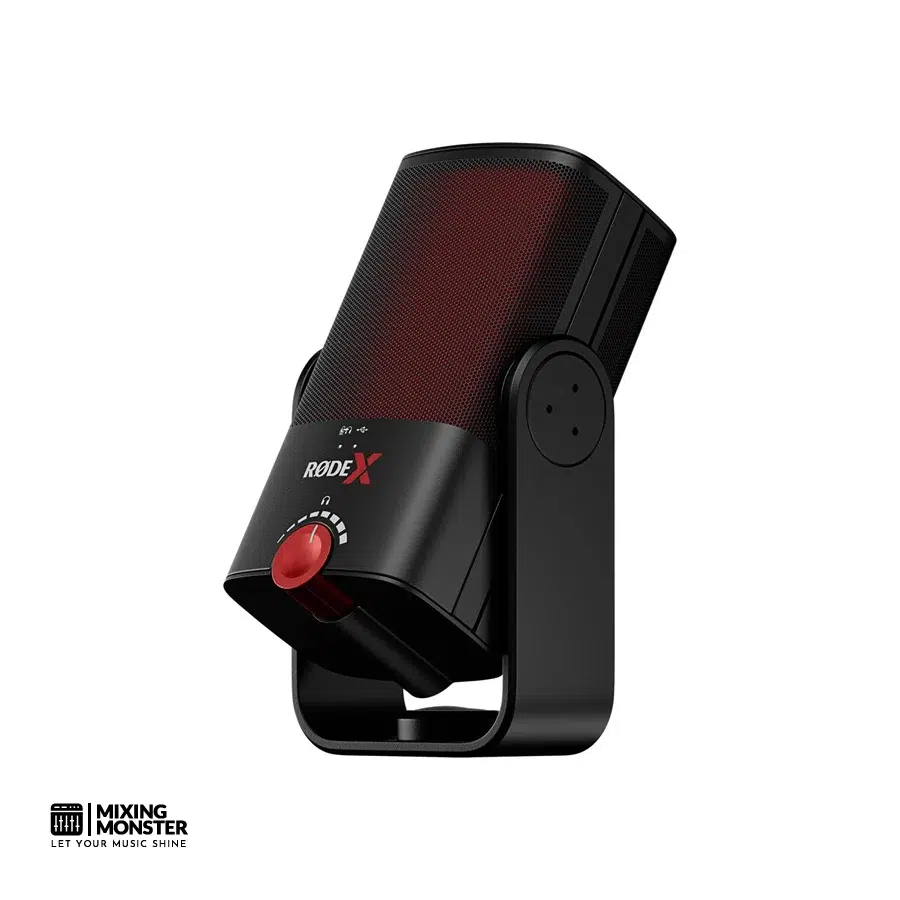
Overview:
The RØDE X XCM-50 Professional USB Condenser Microphone brings studio-level audio right to streamers and gamers. RØDE packed pro condenser technology into a USB-friendly design, so you don’t need extra gear.
The XCM-50 comes bundled with RØDE’s UNIFY virtual mixing software, which lets you control your sources and effects with surprising depth. The integrated 360-degree swing mount and included tripod make it simple to find the right angle for your setup.
Pros:
- Clear, professional sound from a real condenser capsule
- UNIFY software gives you tons of mixing and voice effect options
- Zero-latency headphone monitoring and built-in level controls
- Flexible mounting—swing arm and sturdy tripod included
- USB plug-and-play, no extra hardware needed
Cons:
- UNIFY software doesn’t work on Mac (yet)
- Costs more than basic USB mics
- Small size means you need to position it close for the best results
Unique Selling Point:
The XCM-50 combines professional condenser mic quality with full-featured software, targeting content creators and gamers who want more than just a basic mic.
Key Benefits:
- Professional Audio Quality: The condenser capsule delivers broadcast-level sound, genuinely enhancing your stream or gaming audio.
- Complete Software Solution: UNIFY lets you mix, process, and add effects live—no extra apps or gear needed.
- Streamlined Setup: The all-in-one USB design and included accessories simplify setup, eliminating the need for complicated routing.
Pricing:
| Average Price | ~ $149 |
Review:
The RØDE XCM-50 made a strong first impression with its sturdy feel and well-thought-out design for creators. Everything you need comes in the box, so you can get up and running for pro-level streaming fast. Even though it’s small, it doesn’t skimp on audio quality—our vocals sounded crisp and detailed, right up there with much bigger mics.
Setup was a breeze on Windows—plug it in and you’re set. The swing mount is a smart addition, allowing us to adjust placement without needing extra stands. The tripod’s no afterthought either; it’s stable and keeps the mic steady on the desk.
Sound-wise, the cardioid polar pattern does a great job cutting out background noise while keeping vocals front and center. We heard subtle details in our voices, and didn’t get that harsh, brittle sound you sometimes get from USB mics. The pop filter helps with plosives, but you’ll still want to pay attention to your mic technique.
UNIFY software is a real bonus if you’re on Windows. We found the live mixing and voice processing super handy for streaming. The interface is straightforward, so you can tweak levels and effects without getting lost. Fun features like reverb and pitch shifting work smoothly and don’t introduce any noticeable lag.
Zero-latency headphone monitoring makes a noticeable difference—it’s easier to maintain a natural delivery when you’re not distracted by delay. The mute button and on-body level control are convenient, too, so you don’t have to dig into software mid-session. Monitoring sounds clean and has enough power for most headphones.
Our biggest gripe is that Mac users cannot yet use the complete software suite, which feels like a missed opportunity. Additionally, since it’s so compact, you’ll want to pay attention to placement to achieve optimal sound quality. Still, the XCM-50 offers pro-grade audio and a feature set that makes it worth considering if you’re serious about streaming or gaming.
#5 Elgato Wave:3
Best For Streamers, Podcasters, And Content Creators
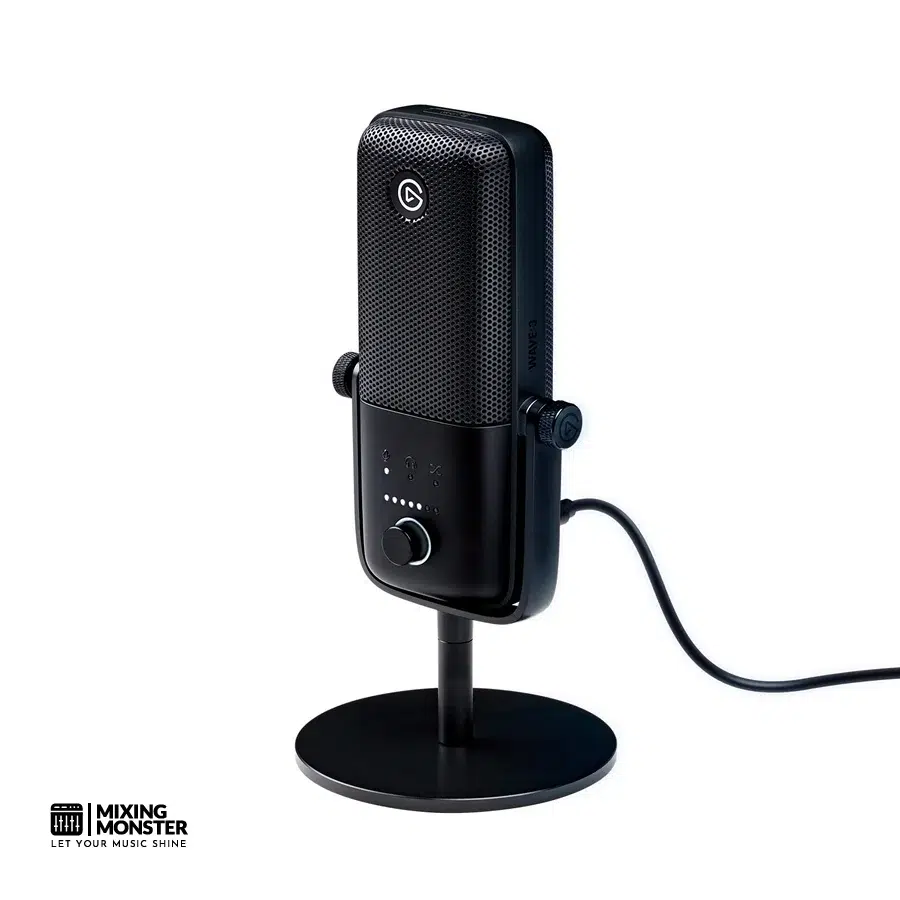
Overview:
The Elgato Wave:3 offers broadcast-quality audio with the convenience of USB for content creators. This condenser mic features anti-distortion technology and a sleek capacitive mute button.
The included Wave Link software lets you mix multiple audio sources. We liked the mic’s compact, sturdy build during our hands-on tests.
Pros:
- The capacitive mute button is fast and silent
- Wave Link software gives you granular audio control
- Anti-distortion tech keeps clipping at bay
- Zero-latency headphone monitoring is a must-have
- Sound quality is clean and professional
Cons:
- Software setup feels a bit much for newcomers
- Costs more than the entry-level crowd
- A chunky base takes up real estate on your desk
Unique Selling Point:
The Wave:3‘s Clipguard technology is a lifesaver for distortion, and the Wave Link software can essentially run your entire audio workflow—a massive plus for creators.
Key Benefits:
- Professional Audio Quality: Cardioid condenser capsule nails vocal clarity and detail
- Complete Audio Control: Wave Link lets you juggle multiple sources and build separate mixes for streaming
- User-Friendly Operation: Mute button and twist dial keep things simple when you’re live
Pricing:
| Average Price | ~ $149 |
Review:
The Elgato Wave:3 feels reassuringly solid and looks sharp on any desk. The matte black finish is understated but pro. We loved having a mute button that doesn’t click or pop—just a gentle tap and you’re muted.
Sound quality? Genuinely impressive. Our vocals came through clear, and the cardioid pattern did a great job cutting out unwanted noise. The anti-distortion tech really proved itself when we pushed the gain or raised our voices.
Wave Link software is where this mic really shines. You can set up different mixes for yourself and your stream, adjust individual audio sources, and add effects on the fly. It takes a little time to learn, but once you get it, the control is fantastic.
The twist dial on the mic gives you quick access to gain and monitor levels—no need to dig through menus. We found zero-latency monitoring essential for staying in the groove while recording. USB-C connectivity works across devices, which is always a relief.
Downsides? The base is substantial, so ensure you’ve sufficient space for it. And if you’re not into fiddling with software, the initial setup might feel overwhelming. But if you’re serious about content, the Wave:3 has the features and sound to match.
Best Midrange USB Microphones
#6 AKG Lyra Ultra-HD USB C
Best For Multi-Mode Recording And Content Creation

Overview:
The AKG Lyra Ultra-HD USB Microphone delivers professional-grade audio thanks to its four-capsule array and flexible recording modes. We’ve used this mic in everything from podcasting to music production, and it seamlessly adapts to each scenario.
The AKG Lyra records at 24-bit/192kHz and plays nicely with PC, Mac, and mobile devices. Plug it in, and you’re ready to go—no complicated setup required. If you’re into music, the included Ableton Live 10 Lite is a nice bonus.
Pros:
- Four distinct recording modes handle various audio scenarios effectively
- Exceptional build quality with professional metal construction
- Zero-latency headphone monitoring with independent volume controls
Cons:
- Larger desktop footprint compared to compact alternatives
- Button placement could be more intuitive for frequent adjustments
- Premium pricing puts it above entry-level USB microphones
Unique Selling Point:
The AKG Lyra stands out with its adaptive four-capsule array that automatically optimizes pickup patterns based on your selected recording mode, delivering studio-quality results without manual tweaking.
Key Benefits:
- Multi-mode versatility – Four recording modes (Front, Front & Back, Tight Stereo, Wide Stereo) adapt to different content types and room acoustics.
- Professional monitoring capabilities – Built-in headphone output with independent mix controls lets us monitor recordings in real-time without latency.
- Universal compatibility – Works instantly with computers, tablets, and smartphones, requiring no additional drivers or software.
Pricing:
| Average Price | ~ $155 |
Review:
We’ve been running the AKG Lyra through its paces in various recording situations, and honestly, it’s tough not to be impressed. The four-capsule design feels substantial right out of the box—this thing means business, and the metal build gives off serious pro vibes.
Setup? Couldn’t be easier. We plugged it into the computer and started recording in seconds. Those four recording modes aren’t just for show; Front mode excels at solo podcasting and vocals, while Front & Back is ideal for interviews—both voices come through crisp and clear without requiring mic placement adjustments.
It’s the sound that really seals the deal. Vocals come across rich and detailed, never harsh. The built-in pop filter helps with plosives, though, let’s be real, good mic technique still matters. The 24-bit/192kHz recording captures subtlety that most budget mics can’t touch.
The onboard controls are handy—dedicated knobs for headphone volume, mic gain, and output mix make life easier. The mute button is a lifesaver when you need quick silence, but we did have to get used to the controls since they’re tucked away on the back.
On the desk, the integrated stand keeps it stable, but you’ll want some space—it’s not exactly petite. We ended up mounting it on a boom arm for more flexibility. The USB-C port feels solid, and the cable length is just about right for most setups.
After weeks of use, the AKG Lyra proves its worth for serious content creators and musicians. The combination of build quality, audio performance, and genuine versatility makes it a solid investment despite the higher price point.
#7 Sennheiser Profile
Best For Professional Podcasters, Streamers, And Content Creators

Overview:
Sennheiser’s Profile is a plug-and-play USB mic aimed at creators who want pro results without the fuss. This German-engineered cardioid condenser microphone features sturdy all-metal construction and provides direct hardware controls for gain, mix, and volume.
You connect it via USB-C to just about anything—computer, tablet, phone—no extra software needed. The capsule tech here has won awards for a reason; vocals come through with warmth and presence that really flatter the human voice.
Pros:
- Zero-latency headphone monitoring with crystal-clear audio quality
- Robust all-metal construction that withstands daily studio use
- Intuitive hardware controls eliminate dependency on software
- Universal USB-C compatibility across multiple devices
- Professional-grade German-engineered capsule technology
Cons:
- Premium pricing puts it out of reach for budget-conscious creators
- Heavier weight compared to plastic alternatives may stress the lightweight boom arms
- Limited polar pattern options restrict versatility for different recording scenarios
Unique Selling Point:
The Sennheiser Profile distinguishes itself through its comprehensive hardware-based control system, enabling creators to adjust all essential parameters without needing to access software interfaces during live recordings or streams.
Key Benefits:
- Immediate Setup – We connect the Profile and start recording within seconds, with no driver installation or complex configuration required.
- Professional Audio Quality – The German-engineered capsule captures vocals with exceptional clarity while effectively rejecting background noise and room reflections.
- Hands-On Control – Physical knobs for gain, mix, and volume provide tactile feedback and instant adjustments during critical recording moments.
Pricing:
| Average Price | ~ $159 |
Review:
We’ve put the Sennheiser Profile through its paces in various content creation setups, and it’s clear that this mic is built for professionals. Right away, the solid metal body stands out—it feels premium and ready for heavy use. Plugging it in with a USB-C cable, our computer recognized it instantly. No driver headaches, no fiddling.
The sound is the real draw here. Whether recording podcasts, streaming, or doing voiceovers, we got warm, natural vocals every time. The cardioid pattern does a great job isolating our voice and keeping out most of the room noise and keyboard clatter. We picked up on subtle vocal details, and thankfully, there is no harshness or weird coloration.
We relied heavily on the hardware controls, especially during live sessions. Adjusting the gain between speakers was quick and didn’t mess up our workflow. Zero-latency headphone monitoring allows us to identify issues instantly, and the mix control ensures perfect balance between playback and mic input for streaming.
The Profile does have some heft, so you’ll want a sturdy boom arm or desk mount—lighter stands might struggle. The tilt mechanism is secure and easy to adjust. The included stand works, but we ultimately preferred a boom arm for improved placement.
Honestly, this isn’t a mic for casual users. The price reflects the pro-grade components and German craftsmanship. If you’re podcasting, streaming, or doing voice work and you care about sound and efficiency, the Sennheiser Profile is a smart pick. It keeps us focused on content, not software tweaks, and works—every time.
#8 Audio-Technica AT2020USB-X
Best For Content Creators, Podcasters, And Home Studio Recording
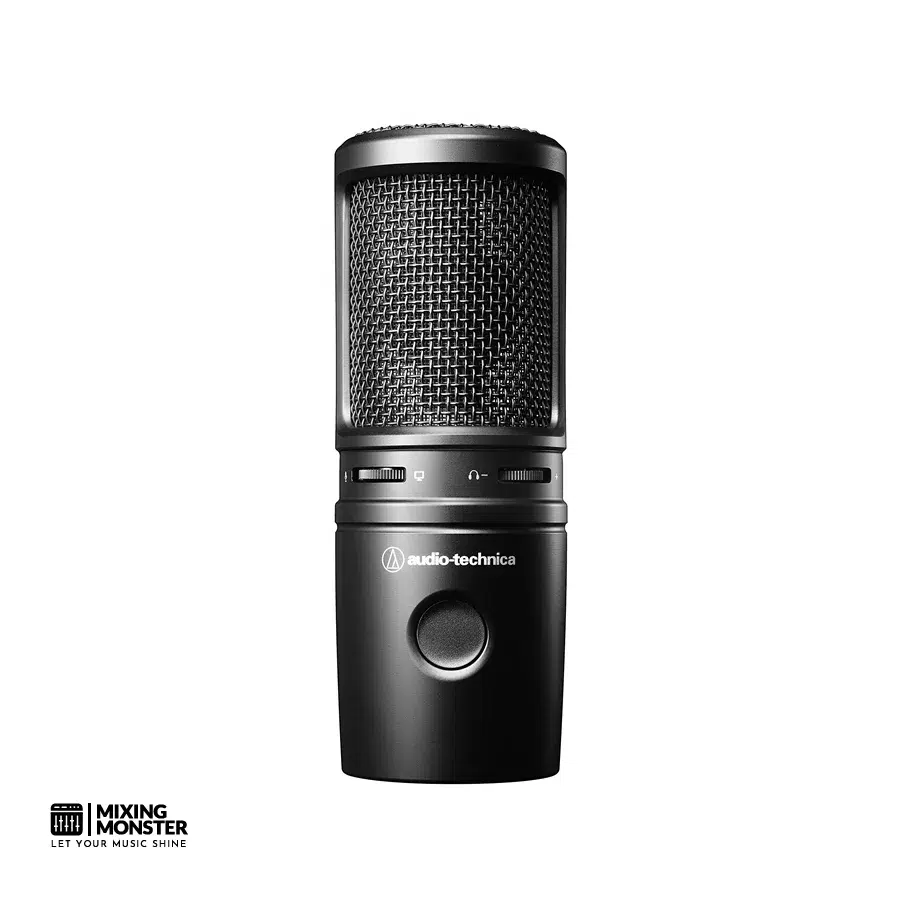
Overview:
The Audio-Technica AT2020USB-X brings pro-level audio and modern features for creators. Building on the classic AT2020, it adds a silent mute button and direct headphone monitoring.
We found it nails natural voice capture with its cardioid pattern. The included desk stand and plug-and-play setup mean you’re up and running right away.
Pros:
- Exceptional audio clarity with natural sound reproduction
- Built-in headphone monitoring with zero latency
- Silent touch-sensitive mute button for seamless operation
- USB-C connectivity with included adapters
- Sturdy construction with professional build quality
Cons:
- It can oversaturate when positioned too close to the mouth
- Requires careful positioning to avoid plosive sounds
- Higher price point compared to entry-level USB microphones
Unique Selling Point:
The AT2020USB-X stands out with its combination of Audio-Technica’s acclaimed condenser capsule technology and modern content creator features like silent muting and direct monitoring capabilities.
Key Benefits:
- Professional Audio Quality – The high-resolution A/D converter captures voice with studio-grade clarity, elevating any recording project.
- Real-Time Monitoring – The built-in headphone output allows us to hear precisely what we’re recording without delay, thereby improving recording accuracy.
- Streamlined Workflow – The silent mute button and plug-and-play design eliminate technical distractions during recording sessions, allowing for seamless operation.
Pricing:
| Average Price | ~ $169 |
Review:
We’ve spent plenty of time with the Audio-Technica AT2020USB-X, and it consistently performs well in every scenario we’ve thrown at it. The mic captures voices with a clarity and warmth that instantly upgrades podcasts and streams. Setup is a breeze—plug in via USB-C and you’re up and running, with no drivers or extra software required.
The cardioid pattern does a solid job picking up your voice and keeping room noise at bay. We got the best results with the mic slightly off-axis, which helps avoid saturation—something to keep in mind if you tend to get close. The included desk stand is sturdy, but if your desk is bouncy or you’re prone to clumsiness, a shock mount is a worthwhile consideration.
Real-time monitoring through the headphone jack is a lifesaver. Zero-latency playback means we catch audio problems as they happen, not after the fact. The mix control is excellent for blending computer audio with your microphone, making it ideal for both live streaming and other applications.
This thing feels premium—good weight, quality materials, and the silent mute button is responsive. The LED ring clearly indicates whether you’re live or muted. We appreciated the thoughtful touches, such as the accessible controls and the included USB adapters for various devices.
Sure, it’s not the cheapest, but the sound quality more than makes up for it if you’re serious about content. Whether it’s a quiet podcast or a rowdy gaming session, the AT2020USB-X handles it with ease. If you want pro results without the hassle of traditional audio gear, this mic delivers.
#9 RØDE NT-USB+
Best For Professional Podcasters, Musicians, And Content Creators
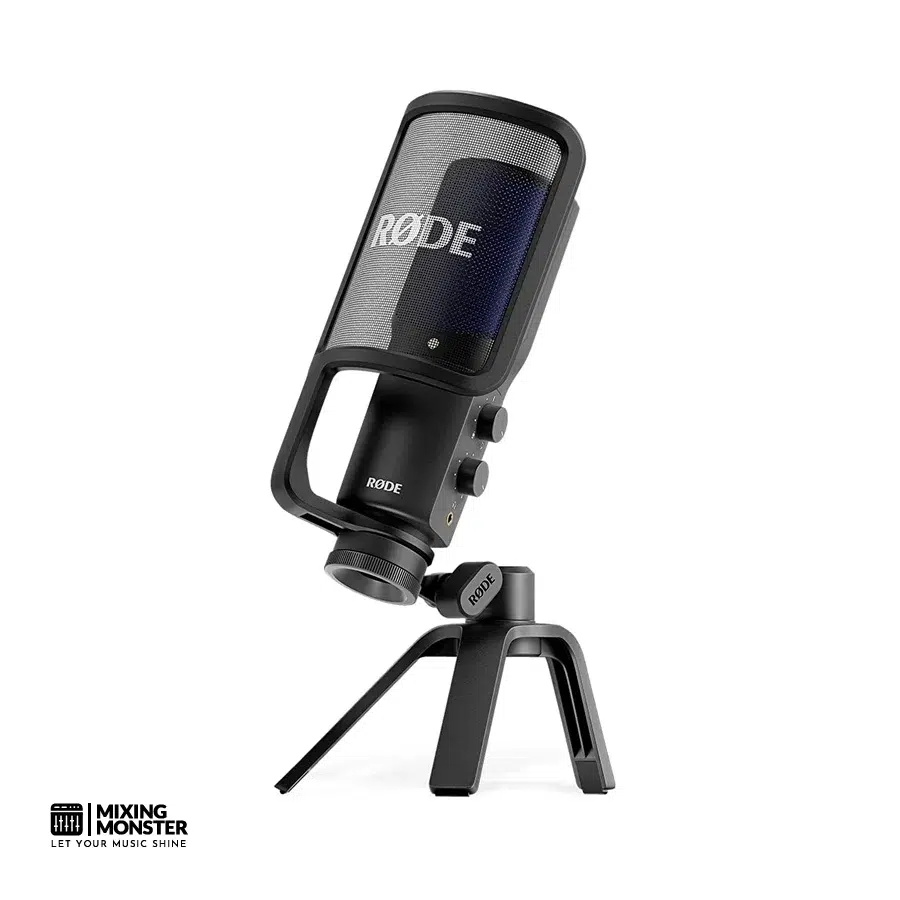
Overview:
The RØDE NT-USB+ brings studio-quality audio recording to your desk without the usual fuss. We tested this USB condenser mic in various settings—music production, podcasting, and streaming—and it handled everything we threw at it.
RØDE took the original NT-USB and packed in some nice upgrades. It’s a proper plug-and-play solution: open the box, and you’re ready to record – no extra gear needed. The USB-C connection works with computers, tablets, and even smartphones, which is honestly pretty handy.
Pros:
- Exceptional audio clarity with a studio-grade condenser capsule
- Zero-latency headphone monitoring with powerful output
- Complete package includes pop filter and desktop stand
- Advanced APHEX audio processing through RØDE Central software
- Universal compatibility across devices without additional drivers
Cons:
- Premium pricing compared to basic USB microphones
- Requires desktop space due to the included stand design
- Some users report occasional software connectivity issues
- May pick up ambient room noise without proper acoustic treatment
Unique Selling Point:
The NT-USB+ really shines thanks to its revolutionary preamp technology. You get ultra-low-noise, high-gain performance—think classic XLR mic quality, but with the ease of USB. Not bad for something this simple to set up.
Key Benefits:
- Professional Audio Quality – The studio-grade condenser capsule captures the subtle details and nuances in both vocals and instruments, resulting in broadcast-level sound.
- Complete Recording Solution – We appreciate that it comes with a pop filter, desktop stand, and cables all in one box. No annoying extra purchases just to get started.
- Versatile Device Compatibility – USB-C means it works with virtually anything—computers, tablets, and even phones. If you bounce between platforms, this is a huge plus.
Pricing:
| Average Price | ~ $179 |
Review:
We put the RØDE NT-USB+ through its paces in various recording scenarios, and it consistently performed well every time. The build feels solid and pro, with a matte black finish that doesn’t scream for attention but looks sharp on any desk. Setup is laughably quick—plug in the USB-C cable, and you’re rolling—no drivers, no weird settings, just record.
The first time we hit record, the audio quality jumped out at us. Vocals come through crisp and detailed, and the frequency response feels balanced, with warm lows and clear highs. It handles dynamic range surprisingly well, even with louder sources like acoustic guitars or heated podcast debates.
Zero-latency headphone monitoring is another highlight. The headphone output offers plenty of volume and sounds crystal clear, allowing you to hear yourself in real-time—without any distracting lag. Onboard controls for headphone volume and monitoring mix are conveniently located, and they’re easy to adjust on the fly.
The APHEX audio processing, available via RØDE Central, adds significant value. Legendary processors like the Aural Exciter and Big Bottom bring out presence and warmth, which we found especially useful for podcasting—your voice cuts through background music and noise with less effort.
Background noise rejection works well, but it’s not perfect. The unidirectional pattern blocks a lot from the sides and back, but if you’re in a noisy or untreated room, you’ll still catch some ambient sound.
Use the included pop filter with the NT-USB+ — it really helps with plosives and breath noise. We tested it for music, podcasts, and video calls, and it handled all three with no fuss.
#10 RØDE PodMic USB
Best For Professional Podcasting And Content Creation
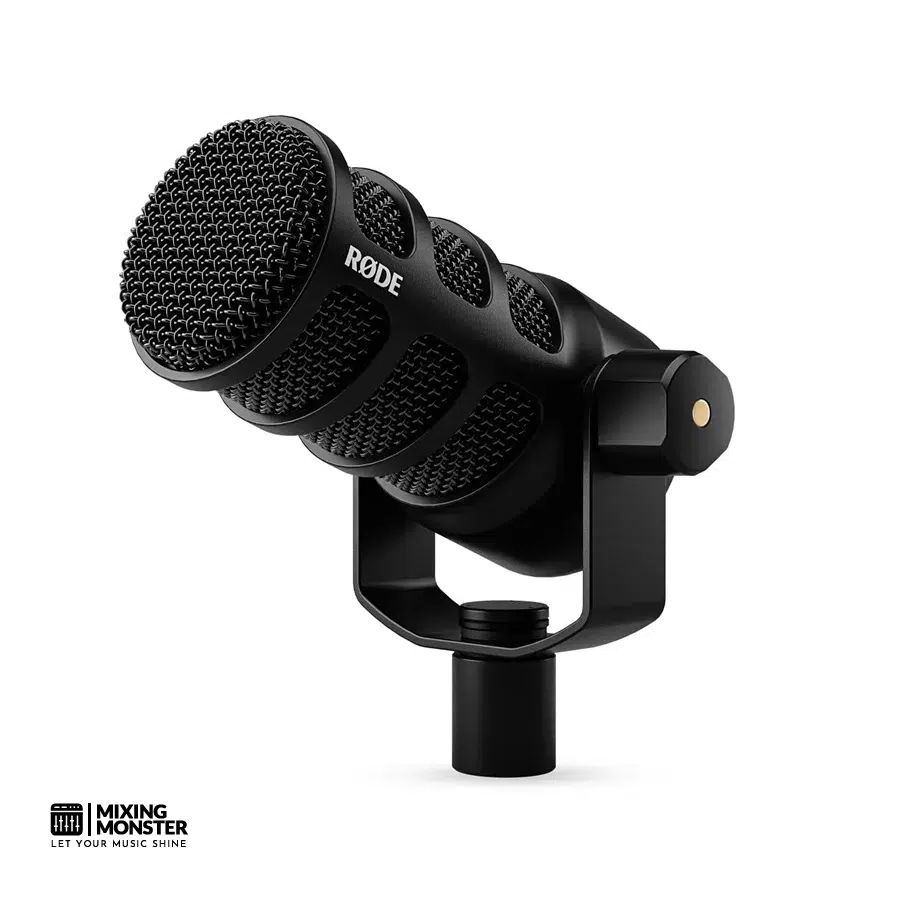
Overview:
The RØDE PodMic USB brings broadcast-quality sound and some serious flexibility to content creators. It’s a dynamic mic with both XLR and USB connections, allowing you to use it in a professional studio or plug it directly into your laptop.
The all-metal build feels robust, and it packs integrated DSP processing and zero-latency headphone monitoring. The PodMic USB captures rich, warm vocals and does a solid job minimizing handling noise and plosives.
Pros:
- Dual XLR and USB-C connectivity offers maximum flexibility
- Built-in APHEX digital processing delivers studio-quality sound
- Integrated shock mount and pop filter reduce unwanted noise effectively
Cons:
- Higher price point compared to entry-level USB microphones
- Substantial weight requires a sturdy boom arm or stand
- Advanced features may overwhelm beginner users
Unique Selling Point:
The PodMic USB‘s hybrid connectivity is a real game-changer. You can seamlessly transition between professional audio interfaces and direct computer recording without missing a beat or compromising quality.
Key Benefits:
- Professional Audio Quality – The APHEX processing and dynamic capsule combine for that polished, broadcast-ready sound you hear on top podcasts.
- Ultimate Flexibility – Dual outputs allow you to record directly to your computer or connect to a mixing board as your setup evolves—no need to swap mics as you upgrade.
- User-Friendly Design – With zero-latency monitoring and true plug-and-play operation, you don’t need to be a tech wizard to sound professional.
Pricing:
| Average Price | ~ $209 |
Review:
We’ve logged a lot of hours with the RØDE PodMic USB in various recording situations, and it consistently delivers. The dynamic capsule brings out warmth and clarity in vocals, and the built-in processing gives everything a polished, broadcast feel.
Despite its pro features, setup couldn’t be more straightforward. We plugged it in via USB-C, and the signal was instantly clean—no background hiss. The headphone monitoring is spot-on, with zero latency, so you can trust what you’re hearing in real-time.
The build is no joke. It’s all metal and feels sturdy enough to withstand some abuse, although you’ll want a sturdy boom arm to support the weight. The internal shock mount does a great job of isolating from desk bumps and handling noise.
Sound quality is where this mic really shines. We tried it with all sorts of voices and in different rooms, and it never faltered. The internal pop filter helps with plosives, but adding the external one is still a good idea for the best results. APHEX processing adds a subtle, pro touch without making things sound over-processed.
Having both USB and XLR proved super helpful. We started out recording straight to a laptop, then hooked the PodMic USB up to an audio interface when we upgraded our setup—no need to buy a new mic. That kind of flexibility is rare at this price.
Best High-End USB Microphones
#11 Shure MV88+Stereo USB Mic
Best For Versatile Recording Applications And Content Creators
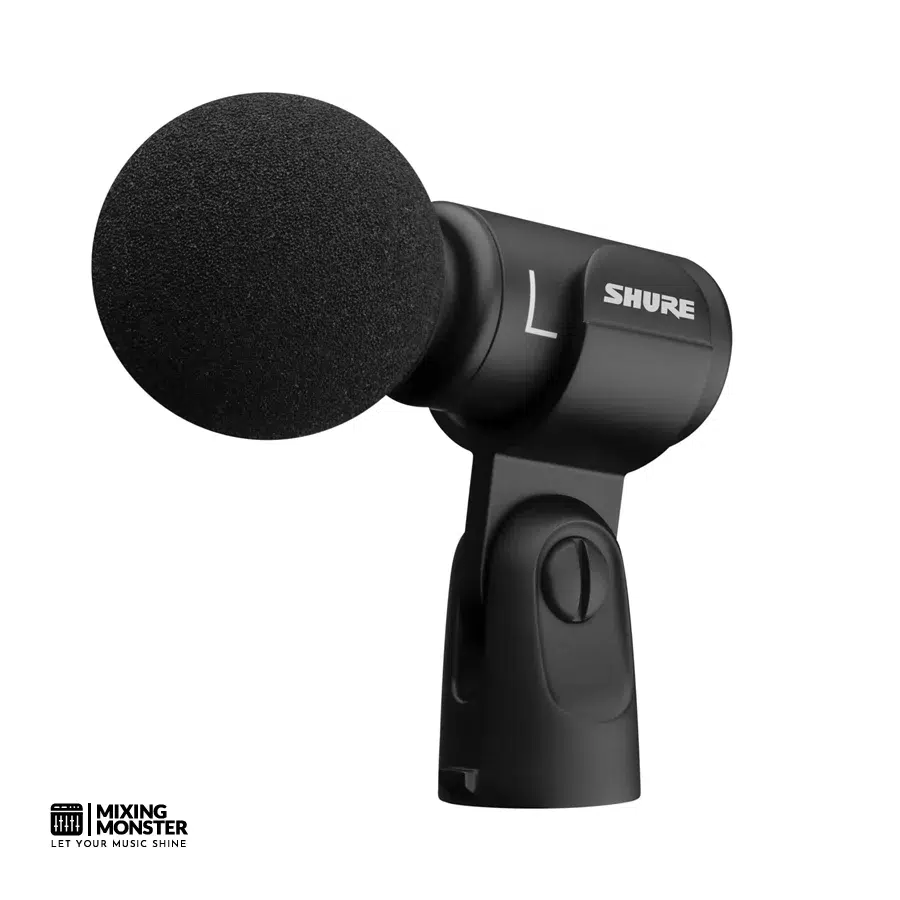
Overview:
The Shure MV88+ Stereo USB Microphone is a compact, adaptable option for recording vocals and instruments. With multiple pickup patterns and built-in DSP, it plugs right into Mac or Windows via USB—real-time headphone monitoring and full app integration round out the package.
The ShurePlus MOTIV Desktop App provides you with deep control, and its portable design allows you to transition from studio to mobile recording easily.
Pros:
- Multiple pickup patterns, including stereo, mono, and bi-directional options, provide recording flexibility
- Built-in headphone monitoring with 3.5mm output allows real-time audio feedback
- Comprehensive desktop app offers detailed control over EQ, compression, and DSP presets
- Compact and travel-friendly design with an included carrying pouch
- Compatible with both desktop and mobile devices
Cons:
- Firmware update issues prevent full compatibility with newer iOS devices
- The desktop app occasionally fails to recognize the microphone properly
- Limited volume output compared to other microphones in a similar price range
- Foam windscreen tears easily during removal
Unique Selling Point:
The MV88+ stands out for its switchable pickup patterns and onboard DSP, so you don’t need extra audio gear or complicated software to get a pro sound.
Key Benefits:
- Flexible Recording Options – Multiple pickup patterns let you adapt on the fly, whether you’re recording solo vocals or want a wide stereo image for instruments.
- Professional Audio Processing – Built-in DSP presets and manual controls help you dial in studio-quality sound without the usual gear pile-up.
- Portable Professional Setup – It’s compact, comes with handy accessories, and still delivers pro audio—making it easy to throw in a bag and go.
Pricing:
| Average Price | ~ $219 |
Review:
We’ve spent a considerable amount of time with the Shure MV88+ in various recording applications, and its versatility is impressive for such a compact device.
The switchable pickup patterns are genuinely helpful; we could swap from stereo for acoustic guitar to mono for vocals in seconds. Sound quality is classic Shure—clear highs, balanced mids, and it works for both voice and music.
The ShurePlus MOTIV Desktop App offers extensive control. The DSP presets are a lifesaver if you want to set up quickly, but you can also get hands-on with compression and EQ if you’re more particular. Built-in processing helps you achieve polished results without needing to dive into third-party plugins or external gear.
Headphone monitoring through the 3.5mm output worked perfectly for us. The app allows you to adjust the monitor mix, enabling you to balance your input and computer playback, which is especially helpful for musicians tracking along to backing tracks.
But it’s not all smooth sailing. Firmware updates can be a headache, especially for iOS users, and sometimes the desktop app doesn’t recognize the mic until you reconnect it. These quirks can be frustrating, especially if you’re hoping for a seamless mobile recording setup.
The build quality is decent for the price, but some accessories appear disorganized. The foam windscreen tears too easily, and while the mic itself is light and portable, it doesn’t have the reassuring heft of a studio workhorse.
Still, if you care more about portability and versatility than indestructibility, the MV88+ delivers professional recording power in a travel-friendly package—even if the software side occasionally falls short.
#12 Shure MV7 Plus
Best For Professional Podcasters, Streamers, And Content Creators
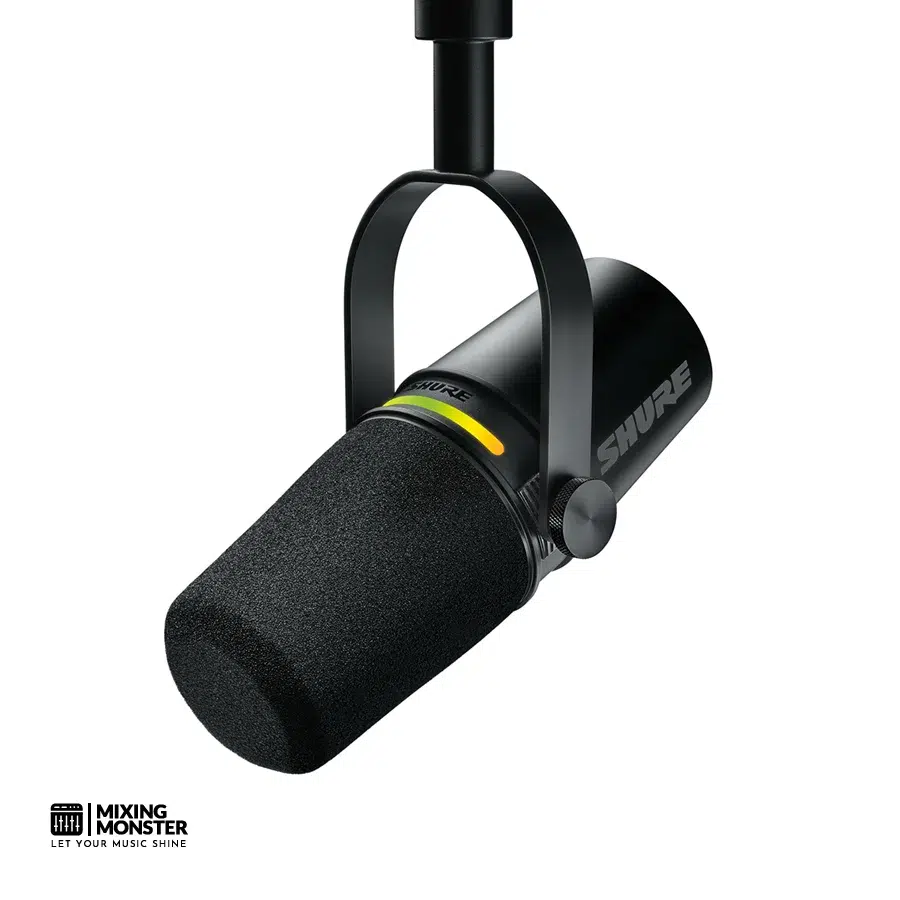
Overview:
The Shure MV7+ represents a notable upgrade to the original MV7, combining professional-level audio capture with a range of modern digital features. We tried out this dynamic microphone and got genuinely excellent sound quality from both its USB-C and XLR connections—so it fits into all sorts of setups.
The LED touch panel is a real eye-catcher, too: you can pick from millions of colors, and it doubles as a mute button. As you’d expect from Shure, it’s built tough, and the DSP processing is a nice bonus for creators who want that broadcast polish.
Pros:
- Excellent audio quality, solid voice isolation
- Dual connectivity (USB-C and XLR) fits any workflow
- Customizable LED touch panel with instant mute and level feedback
- Smart DSP features: real-time denoiser, digital pop filter, auto gain
- Sturdy build and deep app integration
Cons:
- Pricey—definitely not for every budget
- The feature set can feel a bit much for beginners
- Takes some experimenting to really master all the settings
Unique Selling Point:
The MV7+ stands out with its colorful LED touch panel—it’s not just for looks. You can tweak the color, mute with a tap, and keep an eye on your audio levels without missing a beat.
Key Benefits:
- Professional Audio Quality – The dynamic capsule with voice isolation delivers broadcast-level results, effectively reducing background noise and room reverb.
- Flexible Connectivity – USB-C and XLR outputs allow for seamless transition from quick plug-and-play to full-on professional audio gear, with ease.
- Intelligent Processing – Built-in denoiser and pop filter work in real time, and the auto level mode keeps your gain in check without fussing with knobs.
Pricing:
| Average Price | ~ $299 |
Review:
We put the Shure MV7+ through its paces in various recording setups, and it consistently delivered the polished, professional sound you expect at this price. Background noise? Barely an issue, even in less-than-ideal rooms.
Setup was a breeze, either way—USB-C for quick sessions or XLR for when you’re running a complete interface. The auto level mode is a lifesaver if you move around or get loud; it just adjusts on the fly, and you barely have to think about it.
The LED touch panel initially seemed a bit gimmicky, but it proved to be a convenient feature. Mute works instantly, and the level display is clearly visible during longer sessions. The color options are fun and can add a little flair if you’re on camera, although not everyone will care about that.
The digital features held up well. The denoiser removed the hum from AC or computer fans without distorting the voices. The pop filter tamed plosives, though good mic technique still matters—no magic there.
Build-wise, it’s classic Shure: metal, solid, not too heavy. The MOTIV MIX app covers everything you want to tweak, but it takes a little time to get comfortable with all the controls.
If you’re looking for a modern mic that nails the basics and adds some cool extras, the MV7+ is worth considering—if the price doesn’t deter you.
#13 Apogee HypeMiC
Best For Podcasters Who Want Analog Compression And A Polished Sound Straight From The Mic

Overview:
The Apogee Hype Mic is a premium USB mic built for vocals and podcasting. When we tried it, this compact condenser really impressed us with its onboard analog compression—it does the job of post-production plugins right in the hardware.
It records at 24-bit/96kHz, and you get a nice accessory kit, including a carrying case, pop filter, desktop tripod, and more.
Pros:
- Analog compressor bakes in that pro vocal presence—no software needed
- Solid construction and actually useful accessories (the case and pop filter aren’t just afterthoughts)
- Zero-latency monitoring with blend control, so you can hear yourself clearly while recording.
Cons:
- Costs more than your average USB mic
- Needs gain tweaks every time you connect, based on user feedback
- Sometimes it takes a few seconds to appear as an audio source.
Unique Selling Point:
The Hype Mic‘s killer feature is its hardware analog compressor. It adds that polished, in-your-face vocal sound you’d usually only get after editing. Most USB mics rely on software, but this one handles it right inside the mic.
Key Benefits:
- Professional Compression: The built-in analog compressor enhances the clarity and warmth of your voice, enabling you to stand out in the mix.
- Complete Portability: The case is sturdy, the mic’s small, and you can toss the whole kit in a bag for recording anywhere.
- Plug-and-Play Simplicity: Works with Mac, Windows, iOS—no drivers, no headaches. Just plug it in and go.
Pricing:
| Average Price | ~ $399 |
Review:
After extensive recording with the Apogee Hype Mic, we found that the vocal quality really does punch above its weight—easily holding its own against pricier studio mics. The cardioid pattern locks onto your voice and shrugs off most background noise. Setup is quick, and the sound right out of the gate is a clear step up from budget USB mics.
The analog compressor makes a noticeable difference. Our voices came out fuller and more professional, requiring no extra processing. The three compression modes cover most situations, although it may take a moment for the mic to be recognized after plugging in—just something to be aware of.
The build feels premium for a USB mic. It’s metal, not plastic, and the accessories are actually worth using. The case, in particular, keeps everything organized and protected if you’re on the move.
Performance stayed solid across devices. We tested it with different software on both computers and mobile devices, and the sound remained consistent. Zero-latency monitoring is beneficial for longer sessions—eliminating weird echoes or lag in your headphones.
Yes, it’s pricier than entry-level mics, but honestly, the audio quality and built-in compression make it a smart buy for folks who want to skip the editing grind.
The Hype Mic sits in that sweet spot between simple USB mics and complete studio rigs—easy to use, portable, and sounds great right away.

2. What Is A USB Microphone?
A USB microphone plugs straight into your computer’s USB port. No extra audio interface, no complicated setup—connect and go.
Traditional microphones need XLR cables and an interface. USB mics skip all that by handling analog-to-digital conversion inside the mic itself.
The mic converts sound into a digital signal immediately, so your computer recognizes it as a standard audio device—pretty slick.
| USB Microphone | Traditional Microphone |
|---|---|
| Direct USB connection | Requires an audio interface |
| Built-in converter | External converter needed |
| Plug-and-play setup | More complex installation |
Most USB microphones are compatible with Windows, Mac, and Linux. Just plug them in and pick the mic in your software—done.
You’ll find USB mics in all flavors: condenser, dynamic, and even ribbon. Each one has its own strengths, depending on what and where you’re recording.
Condenser USB mics are great for catching details in vocals or instruments. Dynamic USB microphones are robust, capable of handling loud sounds, and effectively block out a lot of background noise.
Most models feature a headphone jack for real-time monitoring, enabling you to hear yourself as you record without any annoying delay. Many models include physical controls for adjusting gain, mute, or headphone volume. You can tweak these right on the mic, which is handy.
The USB cable handles both power and audio, eliminating the need for batteries or wall plugs for most microphones.

3. Essential Accessories To Complement Your USB Microphone
You’ll want a solid mic stand for stability and easy positioning. An adjustable boom arm that clamps to your desk is a game-changer—way more flexible than those little tripod stands.
Pop filters help tame those harsh “P” and “B” sounds. Mount one between you and the mic, and you’re good to go.
Closed-back headphones allow you to monitor in real-time without sound leaking into your microphone. Go for a pair with a flat response if you want to hear things accurately—no extra bass or hype.
| Accessory | Purpose | Price Range |
|---|---|---|
| Boom arm | Positioning & stability | $25-$80 |
| Pop filter | Reduce plosives | $10-$25 |
| Headphones | Monitoring | $50-$200 |
| Shock mount | Vibration isolation | $15-$40 |
Shock mounts help keep vibrations and desk bumps from messing with your recording. The elastic suspension really does make a difference if you’re a fidgeter or have a wobbly desk.
Acoustic treatment can help tame room noise. Foam panels or a portable vocal booth help reduce unwanted echoes and background distractions.
USB extension cables offer increased reach if your microphone needs to be positioned farther away from the computer. Just get a good one so you don’t lose signal quality.
Windshields are handy for outdoor sessions or if you have a drafty room. They slip over the mic head and keep wind noise at bay.
Some simple cable management—such as Velcro ties, clips, or other similar solutions—keeps your space tidy and helps avoid those annoying mid-session yanks or tangles.

4. USB Microphone Buying Guide
When selecting a USB microphone, several factors significantly impact the quality of your recordings and the ease of use.
Audio quality is at the heart of it all. I’d aim for something with at least a 48kHz sample rate and 16-bit depth (though 24-bit feels more pro if you can swing it).
Polar patterns shape how your mic hears the world. Cardioid’s your friend for solo stuff—podcasts, streaming, whatever. Omnidirectional? That one captures everything, making it better for group chats or setting the room vibe.
| Pattern Type | Best For | Sound Pickup |
|---|---|---|
| Cardioid | Solo recording, podcasts | Front-facing only |
| Omnidirectional | Group discussions | All directions |
| Bidirectional | Interviews | Front and back |
Build quality—yeah, it matters. Mics made from metal usually take a beating better than those made from plastic.
Also, check out the frequency response range. A wider range (think 20Hz-20kHz) means the mic can capture more detail, which is especially useful when recording music.
Monitoring capabilities, such as a headphone jack, let you hear what you’re recording as you go. That can save you from a bunch of headaches later.
Controls—stuff like gain knobs, mute switches, and volume dials—can make your life easier or get in the way, depending on what you need.
Compatibility isn’t just about plugging in a USB cable. Double-check your operating system to see if an update or driver adjustment is needed.
Size and portability—if you’re on the move, a smaller mic is just easier. But sometimes the bigger ones do sound better, so it’s a trade-off.
And of course, there’s your budget. If you’re starting, you don’t need to spend a lot of money. But if you’re after that polished, pro sound, you might have to pay a little more.
5. Finding Your Perfect USB Microphone: Key Takeaways
It comes down to three main things: audio quality, what you plan to do with it, and your budget. Figure those out, and you’ll have a much easier time picking the right mic.
Condenser microphones are excellent for vocals and studio work—they’re incredibly detailed, but they also pick up everything, so it’s essential to have a quiet space. Dynamic microphones are better at handling noise and louder sources.
| Microphone Type | Best For | Environment |
|---|---|---|
| Condenser | Vocals, instruments | Quiet rooms |
| Dynamic | Podcasts, streaming | Noisy spaces |
Polar patterns can totally change your results. Cardioid covers most solo setups, while omnidirectional is more suitable for capturing the entire space.
Price ranges vary significantly. You can get started around $50-100, but top-shelf mics run $200-500 or more. You really do get what you pay for, at least most of the time.
Try to match the frequency response to your voice. Some mics hype up specific frequencies, which may or may not work for you.
I always look for solid build quality. Metal bodies and sturdy stands feel more durable, and they usually last longer as well.
Software compatibility can be a dealbreaker. Most mics work with the usual recording apps, but some come with their own software, which can be either a blessing or a pain.
Having a monitoring feature—such as a headphone port—makes recording significantly smoother. Zero-latency is great; nobody wants to hear their voice echo back a half-second late.
If you’re always on the go, portability matters. Smaller mics slip right into your bag, but yeah, sometimes the bigger ones sound fuller.
Our Top Picks For The Best USB Microphones
Best Budget USB Microphones
- Mackie EM-91CU+
- SE Electronics Neom USB
- RØDE NT-USB Mini
- RØDE XCM-50
- Elgato Wave:3
Best Midrange USB Microphones
- AKG Lyra Ultra-HD USB C
- Sennheiser Profile
- Audio-Technica AT2020USB-X
- RØDE NT-USB+
- RØDE PodMic USB
Best High-End USB Microphones
- Shure MV88+Stereo USB Mic
- Shure MV7 Plus
- Apogee HypeMiC

FAQ
1) What is a USB microphone, and how does it work?
A USB microphone is a digital microphone that can be connected to your computer, phone, or tablet using a USB cable. Inside, it features its own analog-to-digital converter that converts audio signals into digital data your device can use.
The capsule captures the sound, converts it into an electrical signal, and the built-in preamp amplifies it. Then, the ADC (analog-to-digital converter) converts it to digital, allowing your computer to understand what to do with it.
With this setup, you don’t need mixers or audio interfaces. Just plug it in and you’re good to go—no fuss.
2) How does the sound quality of USB microphones compare to XLR counterparts?
Some high-end USB microphones truly rival XLR microphones in terms of quality, at least in a controlled recording environment. The biggest difference is usually found in the preamp and converter, rather than the capsule itself.
XLR mics offer more flexibility, as you can easily swap out preamps or interfaces to fine-tune your sound.
USB mics keep things simple. The preamp and converter are already matched, so you get consistent results without needing to worry about additional gear.
3) Are USB microphones good for professional recording?
Many professionals use USB microphones for podcasts, voiceovers, and streaming. They’re easy and deliver steady results, especially in a studio.
For music, though, XLR setups give you more room to experiment—different preamps, compressors, converters, all that stuff.
If the built-in parts are up to par, USB mics can absolutely do the job. It really comes down to what you need and how picky you are about your workflow.
4) What should I consider when selecting a USB microphone?
Pick a polar pattern that fits your space. A cardioid is usually best for solo use, while an omnidirectional microphone is ideal if you want to capture the whole room.
Frequency response determines how the mic perceives your voice. Flat is good for natural sound, but sometimes a slight boost here or there can help your voice stand out.
Build quality matters—check if it feels sturdy, has shock mounting, and comes with useful extras.
5) Can USB microphones be used with mobile devices?
Most USB microphones are compatible with Android devices, provided you have a USB-C or USB-A adapter. Ensure your device has sufficient power to operate the microphone.
For iOS, it’s a bckier. Your microphone must stay within Apple’s power limits, and not every model is compatible with this requirement. Always double-check compatibility if you’re using an iPhone or iPad.
Some microphones are designed specifically for mobile use—usually lighter in power and featuring shorter cables, which is handy when you’re recording on the go.
6) Do USB microphones require special software or drivers to function correctly?
Most USB microphones utilize standard USB audio protocols, allowing you to plug them in and start recording immediately. Modern operating systems pick them up almost instantly.
Some of the more advanced USB microphones come with their own software, offering features such as monitoring, effects, and adjustable settings. You don’t have to use the software, but you might miss out on a few cool extras if you skip it.
Microphones with unusual features or their own special protocols really need drivers. It’s worth double-checking the manufacturer’s specs for any required software before you hit “buy.”

